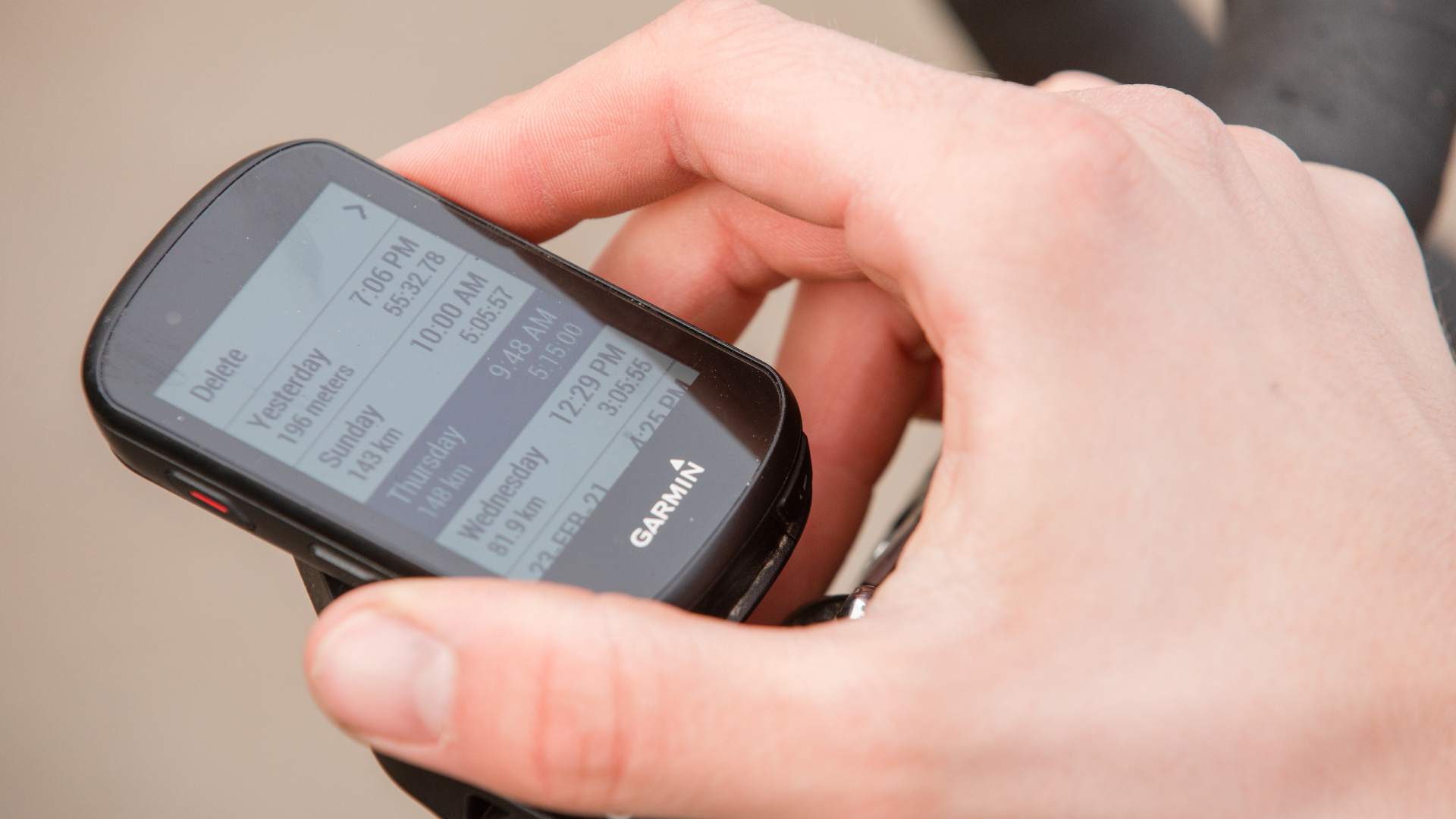Distance versus time - which is best for keeping track of your training volume?
Measuring training has never been easier, but for keeping tabs on volume, is it better to add up the miles or the hours?


Watch a well-drilled group of road cyclists pass by and they might appear to be the picture of perfect harmony, but scratch beneath the surface and there’s a big split: how those riders keep tally of their training volume. Some count up the miles, others the hours. But which side has got it right? And does it matter?
Even the most basic cycle computer records distance and time, while cycling apps like Strava and Garmin Connect have automated the totalling up of training across weeks, months, and even years. This makes it easy to track training volume – essentially, how much you’ve ridden during a specified time period. This allows you to plan for progressive overload, gradually increasing distance or duration each week to keep your body adapting and fitness increasing.
The difference between duration and distance as the measurement of training volume might seem unimportant, at least on the surface. But it’s more contentious and consequential than you might think. In fact, some of the riders and coaches I spoke to for this feature suggested that this choice alone can say a lot about an individual rider, their cycling goals and focus.
“When you hear about people training to time, it’s a symbol of them taking their whole approach to cycling more seriously,” suggests Harry Ashman, a 26-year-old duration convert from London who competes in ultra-distance gravel events. “It’s almost like a microcosm of a larger mindset switch. They’re not riding just for pleasure – they’re thinking about getting fitter, improving and racing.”
Coach Ken Buckley agrees. “For someone who is on the bike for training purposes – to get faster for an event or race – then duration is much better.” Logging time is a mark of athletic seriousness, then. “If you’re just riding for fun and don’t really care about power, heart rate, fitness,” continues Buckley, “it is more fun to tick off distance goals. Everyone talks about their 100-mile rides; they don’t talk about their five hour rides – it doesn’t have quite the same ring to it!”
It’s too early to write off distance just yet, however. In a poll I ran on Twitter, almost a third of respondents (32.4%) said they logged their training by distance. Many riders I spoke to said they preferred tallying up mileage because it meant easier planning and greater psychological satisfaction – ‘getting the miles in’ is a principle not about to die out any time soon. But does racking up hours pay off with greater gains in the long run?
The case for training using distance

Before fitness technology like cycling computers, heart rate monitors and power meters became accessible to the masses, the distance you covered each week was estimated by map work – and was a sign of how serious you were as a rider. The training diary of the most serious of them all, five-time Tour de France winner Eddy Merckx, is the stuff of legend. The Cannibal apparently logged almost 1,000km the week before the 1969 race (and no, there was no mention of hours or minutes).
The latest race content, interviews, features, reviews and expert buying guides, direct to your inbox!
Even with today’s extensive quantity of data fields and the in-depth post-ride analysis offered by our apps, mileage still has its charm. There’s a reason why Cycling Weekly challenges its readers to ride 5,000 miles each year with its CW5000 – that’s 96 miles a week or 13.7 miles a day. A time target of, say, 312 hours (six hours a week) just wouldn’t have the same collective appeal. It’s the same reason why CW’s New Year issue still comes with the iconic annual mileage wall chart – counting miles is a habit that’s hard to shake.
There are benefits beyond accumulating impressive numbers, too. “I find logging distance quite useful if you’ve got a long ride coming up,” says cycling coach Michelle Sharland. “It gives you some progress benchmarks. An improving rider should be slowly increasing their distance by around 10% per week, and if you’re tracking that measurement, you can see if you are overdoing it and heading towards overtraining, have got it just right, or are undercutting it a bit.”
If you’re training for an event of a fixed distance, completing that mileage in training may help to give you confidence. “Ahead of tackling a long race or sportive where you need to ride a certain distance, it can be helpful to know that you can complete that distance in training,” says coach Mark Walker, “or at least get fairly close to it.”
The case against training using distance

Despite the advantages, calculating training volume in distance has a major downside, even if you factor in the intensity using metrics like power or heart rate. “Distance is not a reliable measure of your effort,” explains Buckley. “Riding at a set duration for a set power will always require the same amount of effort, but if you’re riding a set distance, the effort will vary every time depending on terrain and weather.”
Buckley points out that variables including wind, elevation, road surface and kit (bike, clothing, tires) affect your speed and therefore the distance you cover. “There are just too many [variables] for you to be able to say ‘I was a better athlete that day’, whereas if you’re tracking duration and intensity and you produced more watts, then you can categorically say that was a bigger physical performance.”
When tallying only distance, though it may have psychological benefits, you may underestimate the training load, particularly if you have completed lots of short, sharp, high-intensity efforts. “Your accumulated distance may not accurately reflect how hard you’ve worked that week and can be demotivating,” says Sharland, “even when you’ve done everything right.”
The case for training using time
The majority of respondents (67.6%) in my poll said they tracked duration, and they do so with good reason. Almost all pro riders tally up training volume in hours, and all of the coaches I spoke to favoured duration over distance in almost all situations, be it for recording or prescribing training, regardless of a client’s ambitions or goals. “Every part of training should be measurable, repeatable and precise,” says Buckley, “so you have the ability to track your progress reliably.”
So it’s all about logging time, right? Not quite. “If I’m purely going on duration – no other input – it leaves too much grey area and guesswork,” says Sharland. “If I set a two-hour ride but it’s ridden slowly and without purpose, only a short distance will be covered with scant training stimulus, whereas if I say, ‘I want you to do a 30km ride’, there are literally no shortcuts.”
If you’re used to training by distance, switching to duration can seem unappealing. It’s hard to impress your mates with the number of hours you sat on your bike at the weekend, whereas miles are a relatable reference they can visualise and maybe even be awed by. “Sometimes it takes people a bit of time to adjust how they’re thinking about their training when they start focusing on duration,” admits Buckley.
Digging into the data

The accessibility of training data has poured fuel onto the duration vs distance fire, entrenching opinions. Logging multiple metrics has never been easier. All you need is a smartwatch or a phone in a jersey pocket, while relatively inexpensive tools like power meters and heart rate monitors can add extremely detailed breakdowns of efforts and intensities.
What can’t be debated is that tracking training volume is key to making progress. Knowing the amount you have ridden – whether counted in miles or hours – over a week or training block is a crucial measurement. However, that doesn’t mean more is necessarily better. “Increasing your weekly volume by ‘x’ amount isn’t the goal,” says Buckley. “The goal is to go faster through the most efficient stimulus. Besides, for many amateur riders with busy lives, increasing volume isn’t realistic anyway.” Accruing six to 10 hours per week consistently alongside work and family isn’t easy. “Once you’ve nailed consistency, then you can look at what type of riding within those you’re doing and start to make changes specific to your goals,” adds Buckley.
It’s clear, then, that neither distance nor duration is the one data field to rule them all. But when you factor in variables and changes in speed and intensity, duration is the much more reliable method of logging volume. Of course, a whole suite of data fields are now available from GPS devices and training apps. One of the most popular is TrainingPeaks’s training stress score (TSS), which factors in the duration and intensity of a ride to calculate its training load (an estimate of physiological stress), where one hour spent at FTP equals 100.
Buckley uses TSS but not uncritically: “It has its flaws– it doesn’t really catch the difficulty of a workout,” he says. “A session of four 10-minute intervals at threshold, with five minutes’ rest in between each, would produce the same TSS as 40 minutes at threshold straight through, despite the latter being much harder.”
Strava and Garmin offer similar stress measurements free of charge. The TSS equivalent on Strava is Training Load, which benchmarks your average power from a ride against your FTP – a fairly rudimentary method that relies on your FTP being kept up to date. To get the most accurate reading, your head unit needs to have auto-pause on and net zero averaging turned off – and even then should be interpreted with caution.
The results are in
The case is settled: when it comes to tracking training volume, duration wins. Although distance still has its appeal – a 200-mile week will always command more respect than a 12-hour week – if fitness is your focus, then clocking it up by minutes has greater accuracy and is more likely to yield gains in the long-term.
Rider views: two amateur riders with two very different approaches
Harry Ashman, 26, London: “When I first started cycling, I was looking at distance as a measure of output. But I quickly realised as I started training more seriously that you can hide behind distance quite easily – it can’t take into account other important factors. I now train to time but I also think about how much of that time is actually spent pushing the pedals. It helps using metrics like TSS and being realistic about how hard each ride or each hour felt.”
Reece Preston, 31, Burnham-onCrouch, Essex: “I’ve tried training to power and time but I found it dull and boring. These days I tend to go by distance, making it nice and easy to plan a ride. Where I live is so flat that I know 20km takes me generally the same amount of time every time. I’ve got lots of little routes that I can bolt together to make up different distances, so I can easily add or subtract 10 or 20km here and there. If I lived somewhere hillier with climbs that would impact my average speed, I’d probably have to change my ways.”
Tracking the hard stuff: ‘Add up your sessions, not your time in zone’
Polarized training: Splitting your riding roughly 80/20 between low and high intensity is a popular rule of thumb. But should those proportions be based on the number of high- and low-intensity sessions or the time spent in high and low training zones?
“I’ve always focused on programming the high-intensity intervals, not precisely accounting for time in zone,” says coach Mark Walker. “If you try to determine your 80/20 split according to heart rates or power output, it gets too complicated – it may look like you hit 80/20 on one measure but not on another.” Rather than adding up the time spent in particular zones, Walker prefers the simpler ‘session goal’ approach whereby every hard session is classified as high-intensity. The aim is to complete two of these for every 10 sessions ridden.
This full version of this article was published in the print edition of Cycling Weekly. Subscribe online and get the magazine delivered direct to your door every week.

Charlie Allenby is a freelance journalist specialising in cycling, running and fitness. He has written for publications including the Guardian, the Independent, T3, Bike Radar, Runner’s World, Time Out London and Conde Nast Traveller, and cut his teeth as staff writer for Road Cycling UK (RIP). He is also the author of Bike London: A Guide to Cycling in the City. When not chained to his desk, Charlie can be found exploring the lanes and bridlepaths of Hertfordshire and Essex aboard his pink and purple Genesis Fugio.